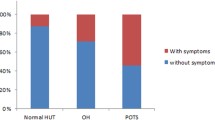Abstract
A variety of approaches have been used to alleviate symptoms in postural tachycardia syndrome (POTS). Drugs reported to be of benefit include midodrine, propranolol, clonidine, and phenobarbital. Other measures used include volume expansion and physical countermaneuvers. These treatments may influence pathophysiologic mechanisms of POTS such as α-receptor dysfunction, β-receptor supersensitivity, venous pooling, and brainstem center dysfunction. The authors prospectively studied hemodynamic indices and symptom scores in patients with POTS who were acutely treated with a variety of interventions. Twenty-one subjects who met the criteria for POTS were studied (20 women, 1 man; mean age, 28.7±6.8 y; age range, 14–39 y). Patients were studied with a 5-minute headup tilt protocol, ECG monitoring, and noninvasive beat-to-beat blood pressure monitoring, all before and after the administration of an intervention (intravenous saline, midodrine, propranolol, clonidine, or phenobarbital). The hemodynamic indices studied were heart rate (ECG) and systolic, mean, and diastolic blood pressure. Patients used a balanced verbal scale to record any change in their symptoms between the tilts. Symptom scores improved significantly after the patients received midodrine and saline. Midodrine and propranolol reduced the resting heart rate response to tilt (p<0.005) and the immediate and 5-minute heart rate responses to tilt (p<0.002). Clonidine accentuated the immediate decrease in blood pressure on tilt up (p<0.05). It was concluded that midodrine and intravenous saline are effective in decreasing symptoms on tilt in patients with POTS when given acutely. Effects of treatments on heart rate and blood pressure responses generally reflected the known pharmacologic mechanisms of the agents.
Similar content being viewed by others
References
Jacob G, Shannon JR, Black B, Biaggioni I, Mosqueda-Garcia R, Robertson RM, et al. Effects of volume loading and pressor agents in idiopathic orthostatic tachycardia.Circulation 1997; 96:575–580.
Fouad FM, Tadena Thome L, Bravo EL, Tarazi RC. Idiopathic hypovolemia.Ann Intern Med 1986; 104:298–303.
Rosen SG, Cryer PE. Postural tachycardia syndrome: reversal of sympathetic hyperresponsiveness and clinical improvement during sodium loading.Am J Med 1992; 72:847–850.
Streeten DHPOrthostatic disorders of the circulation, mechanisms, manifestations and treatment. New York: Plenum Press; 1987; 143–155.
Low PA, Opfer-Gehrking TL, Textor SC, Schondorf R, Suarez GA, Fealey RD, et al. Comparison of the postural tachycardia syndrome (POTS) with orthostatic hypotension due to autonomic failure.J Auton Nerv Syst 1994; 50:181–188.
Miller JW, Streeten DH. Vascular responsiveness to norepinephrine in sympathicotonic orthostatic intolerance.J Lab Clin Med 1990; 115:549–558.
Low PA, Schondorf R, Novak V, Sandroni P, Opfer-Gehrking TL, Novak P. Postural tachycardia syndrome. In:Clinical autonomic disorders: evaluation and management. 2nd ed. Low PA, ed. Philadelphia: Lippincott-Raven; 1997. pp. 681–697.
Novak V, Novak P, Opfer-Gehrking TL, O'Brien PC, Low PA. Clinical and laboratory indices that enhance the diagnosis of postural tachycardia syndrome.Mayo Clin Proc 1998; 73:1141–1150.
Low PA, Opfer-Gehrking TL, Benarroch EE, Shen W-K. Management strategy for the postural tachycardia syndrome [abstract].Ann Neurol 1994; 36:318.
Wright RA, Kaufmann HC, Perera R, Opfer-Gehrking TL, McElligott MA, Sheng KN, et al. A double-blind, dose-response study of midodrine in neurogenic orthostatic hypotension.Neurology 1998; 51:120–124.
Streeten DHP, Scullard TF. Excessive gravitational blood pooling caused by impaired venous tone is the predominant non-cardiac mechanism of orthostatic intolerance.Clin Sci (Colch) 1996; 90: 277–285.
Low PA, Allison T, McPhee B, Wiseman G, Opfer-Gehrking TL, Spies JM, et al. Efficacy of resistance training in improving orthostatic tolerance in POTS [abstract].Clin Auton Res 1998; 8:279.
Schondorf R, Low PA. Idiopathic postural orthostatic tachycardia syndrome: an attenuated form of acute pandysautonomia?Neurology 1993; 43:132–137.
Jacob G, Wathen MS, Robertson RM, Costa F, Shannon JR, Biaggioni I, et al. The function of systemic and local cardiovascular adrenoreceptors in orthostatic intolerance: evidence of partial dysautonomia [abstract].Clin Auton Res 1996; 6:296–297.
Jacob G, Robertson RM, Costa F, Wathen MS, Stein M, Black BK, et al. The local norepinephrine spillover in arms and legs of patients with idiopathic orthostatic intolerance: evidence of partial dysautonomia [abstract].Clin Auton Res 1997; 7:235.
Author information
Authors and Affiliations
Corresponding author
Rights and permissions
About this article
Cite this article
Gordon, V.M., Opfer-Gehrking, T.L., Novak, V. et al. Hemodynamic and symptomatic effects of acute interventions on tilt in patients with postural tachycardia syndrome. Clinical Autonomic Research 10, 29–33 (2000). https://doi.org/10.1007/BF02291387
Received:
Accepted:
Issue Date:
DOI: https://doi.org/10.1007/BF02291387




